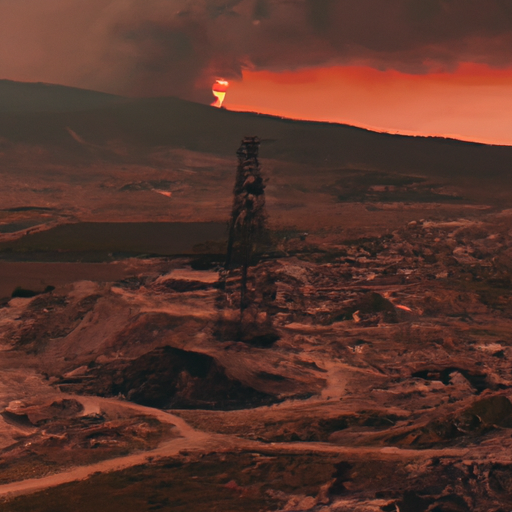
The Economic Consequences of Extreme Weather Events on Europe’s Tourism Industry
Europe’s tourism industry has long been a major contributor to the continent’s economy, attracting millions of visitors each year. However, in recent years, the industry has faced a new and unexpected challenge: extreme weather events. From heatwaves and droughts to heavy rainfall and flooding, Europe has experienced a range of extreme weather conditions that have had a significant impact on its tourism sector.
One of the most obvious economic consequences of extreme weather events on Europe’s tourism industry is the decline in visitor numbers. When extreme weather strikes, tourists are often deterred from traveling to affected areas. For example, during the scorching heatwaves that have hit Southern Europe in recent years, many tourists have chosen to stay away, fearing the health risks associated with high temperatures. Similarly, when heavy rainfall and flooding occur, tourists are less likely to visit destinations that have been affected, as they may be inaccessible or unsafe.
The decline in visitor numbers has a ripple effect on the entire tourism industry. Hotels, restaurants, and other businesses that rely on tourism suffer from reduced revenue and may even be forced to close down. This, in turn, leads to job losses and a decline in the overall economic activity of the region. The impact is particularly severe in areas that heavily depend on tourism as their main source of income, such as coastal regions and popular holiday destinations.
Furthermore, extreme weather events can also damage infrastructure, further exacerbating the economic consequences for the tourism industry. For instance, heavy rainfall and flooding can cause roads and bridges to collapse, making it difficult for tourists to reach their destinations. In addition, extreme heat can lead to wildfires, which not only pose a threat to human life but also destroy natural landscapes and tourist attractions. The cost of repairing and rebuilding infrastructure can be substantial, putting an additional strain on the already struggling tourism industry.
In order to mitigate the economic consequences of extreme weather events on Europe’s tourism industry, it is crucial for stakeholders to take proactive measures. Firstly, investing in climate resilience and adaptation strategies is essential. This includes improving infrastructure to withstand extreme weather conditions, such as building flood defenses and reinforcing buildings. Additionally, diversifying tourism offerings can help reduce the industry’s vulnerability to extreme weather events. By promoting alternative activities and attractions that are less affected by weather conditions, destinations can attract visitors even during periods of extreme weather.
Furthermore, collaboration between the public and private sectors is crucial in addressing the challenges posed by extreme weather events. Governments can provide financial support and incentives to businesses in the tourism industry to invest in climate resilience measures. At the same time, businesses can work together to develop contingency plans and share best practices for dealing with extreme weather events. By working together, stakeholders can better prepare for and respond to the impact of extreme weather on Europe’s tourism industry.
In conclusion, extreme weather events have had a significant impact on Europe’s tourism industry, leading to a decline in visitor numbers, economic losses, and damage to infrastructure. However, by investing in climate resilience, diversifying tourism offerings, and fostering collaboration between stakeholders, the industry can better prepare for and mitigate the consequences of extreme weather. Ultimately, ensuring the long-term sustainability of Europe’s tourism industry requires a proactive and coordinated approach to address the challenges posed by extreme weather events.
Strategies to Mitigate the Impact of Extreme Weather on Europe’s Travel and Tourism Sector

Europe’s travel and tourism sector has long been a thriving industry, attracting millions of visitors each year. However, in recent years, the sector has faced a new challenge: extreme weather events. From heatwaves and droughts to heavy rainfall and flooding, Europe has experienced a range of extreme weather conditions that have had a significant impact on the tourism industry. In this article, we will explore some strategies that can help mitigate the impact of extreme weather on Europe’s travel and tourism sector.
One of the key strategies to mitigate the impact of extreme weather on Europe’s travel and tourism sector is to invest in infrastructure that can withstand extreme weather conditions. This includes building stronger and more resilient hotels, airports, and transportation systems. By investing in infrastructure that can withstand extreme weather events, the travel and tourism sector can continue to operate even in the face of adverse weather conditions.
Another strategy is to diversify tourism offerings. Europe is known for its beautiful beaches and historical landmarks, but extreme weather events can make these attractions inaccessible or less appealing to tourists. By diversifying tourism offerings, such as promoting indoor attractions like museums and art galleries, the sector can continue to attract visitors even during extreme weather events. Additionally, promoting alternative destinations that are less prone to extreme weather can help spread the impact of extreme weather events across different regions.
Furthermore, it is crucial for the travel and tourism sector to improve its communication and coordination during extreme weather events. This includes providing timely and accurate information to tourists about weather conditions and any potential disruptions to their travel plans. By keeping tourists informed, the sector can help minimize the impact of extreme weather events on their travel experiences. Additionally, improved coordination between different stakeholders in the sector, such as hotels, airlines, and tour operators, can help ensure a more seamless response to extreme weather events.
In addition to these strategies, it is also important for the travel and tourism sector to prioritize sustainability. Extreme weather events are often linked to climate change, and the sector has a responsibility to reduce its carbon footprint and contribute to efforts to mitigate climate change. This can be done through initiatives such as promoting eco-friendly transportation options, encouraging sustainable practices in hotels and resorts, and supporting local communities in adapting to the impacts of climate change.
Lastly, the travel and tourism sector should consider the long-term implications of extreme weather events and plan accordingly. This includes conducting risk assessments and developing contingency plans to minimize the impact of extreme weather events on the sector. By being proactive and prepared, the sector can better navigate the challenges posed by extreme weather and ensure the continued growth and success of Europe’s travel and tourism industry.
In conclusion, extreme weather events pose a significant challenge to Europe’s travel and tourism sector. However, by investing in resilient infrastructure, diversifying tourism offerings, improving communication and coordination, prioritizing sustainability, and planning for the long-term, the sector can mitigate the impact of extreme weather and continue to thrive. With these strategies in place, Europe’s travel and tourism industry can adapt to the changing climate and continue to offer unforgettable experiences to visitors from around the world.
Adapting to Climate Change: How the Travel Industry in Europe Can Prepare for Extreme Weather
Europe’s travel industry has long been a thriving sector, attracting millions of tourists each year. However, with the increasing frequency and intensity of extreme weather events, the industry is facing new challenges that it must adapt to in order to continue thriving. In this article, we will explore how the travel industry in Europe can prepare for the impact of extreme weather and ensure the safety and satisfaction of its customers.
One of the first steps that the travel industry can take is to invest in advanced weather monitoring systems. By having access to real-time weather data, travel companies can better anticipate and prepare for extreme weather events. This will allow them to make informed decisions about whether to proceed with travel plans or to make necessary adjustments to ensure the safety of their customers.
In addition to monitoring weather conditions, the travel industry can also invest in infrastructure improvements. This includes strengthening buildings and transportation systems to withstand extreme weather events. By doing so, travel companies can minimize the disruption caused by these events and ensure that their customers are not left stranded or in unsafe conditions.
Another important aspect of preparing for extreme weather is to educate and train staff members. Travel industry professionals should be equipped with the knowledge and skills to handle emergency situations that may arise as a result of extreme weather. This includes knowing how to communicate with customers, provide necessary assistance, and make quick decisions to ensure their safety.
Furthermore, the travel industry can also play a role in promoting sustainable tourism practices. Climate change is largely driven by human activities, and the travel industry is no exception. By adopting sustainable practices, such as reducing carbon emissions and promoting eco-friendly accommodations and transportation options, the industry can help mitigate the impact of climate change and reduce the likelihood of extreme weather events.
Collaboration is also key in preparing for extreme weather. The travel industry should work closely with local authorities, meteorological agencies, and other relevant stakeholders to develop comprehensive emergency response plans. This includes establishing clear communication channels, coordinating evacuation procedures, and providing support to affected areas.
Moreover, the travel industry can leverage technology to enhance preparedness. For example, mobile applications can be developed to provide real-time updates on weather conditions and travel advisories. This will allow travelers to make informed decisions about their travel plans and stay updated on any potential disruptions caused by extreme weather.
Lastly, the travel industry should prioritize customer safety and satisfaction. This means being transparent about the potential risks associated with traveling during extreme weather events and offering flexible booking and cancellation policies. By putting the safety and satisfaction of their customers first, travel companies can build trust and loyalty, even in the face of challenging weather conditions.
In conclusion, the travel industry in Europe must adapt to the impact of extreme weather in order to continue thriving. By investing in advanced weather monitoring systems, improving infrastructure, educating staff members, promoting sustainable practices, collaborating with relevant stakeholders, leveraging technology, and prioritizing customer safety and satisfaction, the industry can effectively prepare for extreme weather events. By doing so, the travel industry can ensure the safety and satisfaction of its customers, while also contributing to the overall resilience of Europe’s tourism sector.


